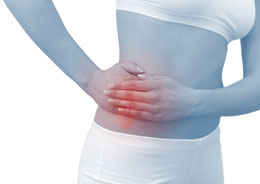A broken rib or even a gallbladder disease can give rise to pain on the right side under the rib cage. To find out more about the other possible causes behind this pain, continue reading this Buzzle article.

The rib cage is a bony structure consisting of 12 pairs of curved bones, that extend from the spine towards the breastbone or sternum. Pain under the rib cage is not uncommon. Most often, such pain is caused by injury to this part of the body. However at times, it can be associated with some underlying health conditions as well. Pain can be felt in the right or the left side. Sometimes, this pain can become quite unbearable. The possible causes of pain under the right rib cage are explained below:
Broken or Fractured Ribs
Broken ribs or any injury to the ribs can manifest in rib pain, as well as pain under the rib cage. Depending on the severity of the condition, the pain can subside within a few days, or it may take months to resolve completely. If the pain is too severe, then pain killers can be required. The pain caused by broken or fractured ribs worsen on bending or moving the body. The extent of injury to the rib cage can be assessed with the help of a chest X-ray.
Costochondritis
Costochondritis is the condition characterized by the inflammation of the muscles and the cartilage, which connect the rib cage to the breastbone. Therefore, pain caused by costochondritis is usually felt in the costosternal joints, where the ribs attach to the breastbone. The pain is usually felt in the left side of the breastbone, but sometimes can occur in the right side as well. The pain might radiate to the area under the rib cage too.
Gallbladder Disease
This type of pain can be caused by gallbladder disease such as formation of gallstones, especially if the pain in recurrent in nature. Gallbladder disease usually leads to such pain after eating, especially if the meal is fatty. The pain can sometimes radiate to the back and between the shoulder blades as well. When the gallstones impede the flow of bile from the gallbladder, one can feel a steady or intermittent pain in the upper abdomen, under the rib cage.
Liver Problems
Liver, as we know is located in the upper right quadrant of the abdomen and so, any kind of problem with the liver can manifest in pain. Liver problems that can be associated with this type of pain include, infections of the liver such as hepatitis A and B, liver damage, and liver cancer.
Mesothelioma
Mesothelium is the thin layer of tissues that covers most of the internal organs in humans. Mesothelioma is a rare type of cancer that affects this thin layer of tissues. There are several types of mesothelioma depending on what part of the mesothelium is affected. The type of mesothelioma that can produce chest pain under rib cage is pleural mesothelioma, where cancer develops in the mesothelium that surrounds the lungs.
Other Possible Causes
Apart from the causes mentioned above, pain under the rib cage on either side can be associated with gas, kidney stones, and irritable bowel syndrome. The pain caused by the formation of kidney stones can be felt in the abdomen or flank below or at the level of the rib cage. Irritable bowel syndrome on the other hand, can cause pain in the abdomen under the rib cage, along with other gastrointestinal problems like, bloating, gas, and constipation or diarrhea.
As this type of pain can be caused by so many different conditions, a proper diagnosis is possible only after studying the nature of the pain in detail. This is the reason why, physicians evaluate the condition after doing a careful study regarding the site of the pain, duration, nature of the pain, and the time of onset. As for example, some people can experience a dull, aching pain, while others can get intense pain. Again, some people can feel such a pain after drinking or eating. Therefore, it is important to consult a physician, if you experience such a pain for a considerable period of time.
Disclaimer: The information provided in this article is solely for educating the reader. It is not intended to be a substitute for the advice of a medical expert.


 The rib cage is a bony structure consisting of 12 pairs of curved bones, that extend from the spine towards the breastbone or sternum. Pain under the rib cage is not uncommon. Most often, such pain is caused by injury to this part of the body. However at times, it can be associated with some underlying health conditions as well. Pain can be felt in the right or the left side. Sometimes, this pain can become quite unbearable. The possible causes of pain under the right rib cage are explained below:
The rib cage is a bony structure consisting of 12 pairs of curved bones, that extend from the spine towards the breastbone or sternum. Pain under the rib cage is not uncommon. Most often, such pain is caused by injury to this part of the body. However at times, it can be associated with some underlying health conditions as well. Pain can be felt in the right or the left side. Sometimes, this pain can become quite unbearable. The possible causes of pain under the right rib cage are explained below: